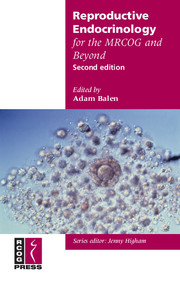Book contents
- Frontmatter
- Contents
- Acknowledgements
- Preface to the first edition
- Preface to the second edition
- Abbreviations used in this book
- 1 Sexual differentiation: intersex disorders
- 2 Adrenal disorders
- 3 Normal puberty and adolescence
- 4 Abnormal puberty
- 5 The menstrual cycle
- 6 Disorders of menstruation
- 7 Amenorrhoea
- 8 Polycystic ovary syndrome
- 9 Health consequences of polycystic ovary syndrome
- 10 Anovulatory infertility and ovulation induction
- 11 Lactation and lactational amenorrhoea
- 12 Hyperprolactinaemia
- 13 Thyroid disease
- 14 Diabetes
- 15 Lipid metabolism and lipoprotein transport
- 16 Premature ovarian failure
- 17 Calcium metabolism and its disorders
- Appendix: Endocrine normal ranges
- Further reading
- Index
10 - Anovulatory infertility and ovulation induction
Published online by Cambridge University Press: 05 August 2014
- Frontmatter
- Contents
- Acknowledgements
- Preface to the first edition
- Preface to the second edition
- Abbreviations used in this book
- 1 Sexual differentiation: intersex disorders
- 2 Adrenal disorders
- 3 Normal puberty and adolescence
- 4 Abnormal puberty
- 5 The menstrual cycle
- 6 Disorders of menstruation
- 7 Amenorrhoea
- 8 Polycystic ovary syndrome
- 9 Health consequences of polycystic ovary syndrome
- 10 Anovulatory infertility and ovulation induction
- 11 Lactation and lactational amenorrhoea
- 12 Hyperprolactinaemia
- 13 Thyroid disease
- 14 Diabetes
- 15 Lipid metabolism and lipoprotein transport
- 16 Premature ovarian failure
- 17 Calcium metabolism and its disorders
- Appendix: Endocrine normal ranges
- Further reading
- Index
Summary
The principles of the management of anovulatory infertility are:
• to correct any underlying disorder (e.g. hypogonadotrophic women who are underweight)
• to optimise health before starting therapy (e.g. women with PCOS who are overweight)
• to induce regular unifollicular ovulation.
A semen analysis should be performed on the male partner before ovulation induction therapy is started. Tubal patency should be assessed by either hysterosalpingo-graphy or laparoscopy before embarking upon gonadotrophin therapy. If there are no firm indications (e.g. past history of pelvic infection, pelvic pain), a reasonable policy is to delay a test of tubal patency until there have been up to three or six ovulatory cycles. A complete assessment of every couple should be performed before choosing the appropriate therapy for inducing ovulation.
Pituitary and hypothalamic causes of anovulation
Anovulation may occur after surgery for pituitary tumours (Figure 10.1), pituitary ablation, Kallmann syndrome and hypogonadotrophic hypogonadism.
HYPOGONADOTROPHIC HYPOGONADISM
If in the presence of estrogen deficiency the gonadotrophin concentrations are subnormal (less than 5 iu/l), hypogonadotrophic hypogonadism should be suspected. The cause may be at the level of the pituitary or hypothalamus. It used to be thought that stimulation with GnRH distinguished between a hypothalamic and pituitary aetiology. However, there is great heterogeneity in the response to a single 100-μg dose of GnRH in women with both hypothalamic and pituitary causes of anovulation. The GnRH test is therefore no longer performed.
- Type
- Chapter
- Information
- Reproductive Endocrinology for the MRCOG and Beyond , pp. 115 - 136Publisher: Cambridge University PressPrint publication year: 2007

